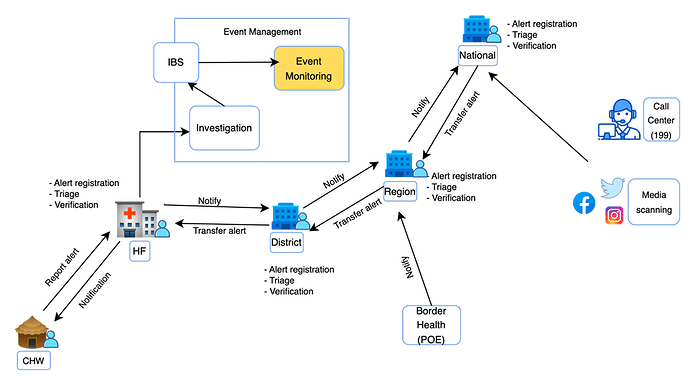By @Bernard , Jimmy Mbelwa, Honest Kimaro, Mwita Sogorya, Vida Mmbaga, Fidelis Ronjino, Zaharani Kalungwa, et al
Greetings! My name is Rajab Mkomwa from Tanzania, I am a Senior System Developer at the University of Dar es Salam (UDSM). Through the UDSM DHIS2 Lab, I have consulted widely in the area of Information Systems, including implementation of government systems in the Health, Social Welfare and Agricultural Sector, using the DHIS2.
I would like to invite you to my presentation during the Annual Conference session named Surveillance,Early Warning & OneHealth pt1 (ENG - FR) planned on Wednesday 14 June, 10:30-12:00 Oslo time zone. You can go through overview of my presentation below.
Background
A flexible and robust surveillance system, including event-based surveillance (EBS), is vital for public health. EBS is an approach to detecting and reporting unstructured ad-hoc information that might signal an outbreak, which might present a serious risk to public health. Despite the crucial nature of EBS’s capacity for a country’s preparedness and early warning system, countries still need assistance to implement EBS. One of the reasons for the poor implementation of EBS is a need for more capacity to strengthen EBS with an optimal balance of sensitivity and specificity to avoid overloading the surveillance infrastructure while maintaining the ability to detect high-threat events very early. Until recently, in Tanzania, there was generally no e-EBS system. Data on outbreak events were collected manually from the community level, health facilities, and other sources, which is time-consuming and decreases timeliness in detecting and responding to the outbreaks. To address the challenge, the UDSM DHIS2 Lab worked with MDH, MoH and stakeholders under CDC funding to design, develop and implement a flexible and robust e-EBS system in Tanzania. The developed e-EBS is mobile-based and web-based for timely reporting and monitoring of public health events at any level
Methodology
The mixed-method approach was employed to develop the e-EBS. The e-EBS is integrated into the existing electronic integrated disease surveillance and response (eIDSR) system. The approach involved conducting several requirement gatherings/analyses and UAT meetings with the MoH, MDH and surveillance system stakeholders to understand and agree on requirements. The DHIS2 platforms were used as the frameworks for developing the e-EBS based on validated requirements, followed by a user acceptance meeting.
Results
The e-EBS is currently used by five (5) selected districts in 3 regions of Tanzania to report alerts. As of 29th April 2023, approximately 300 users have trained to report rumours, alerts, and other public health events. Furthermore, more than 5000 alerts have been reported through the system. Out of 5100 alerts, 3000 were triaged, and 2200 were verified. Overall, the system has increased real-time reporting of public events, improving outbreak detection and response at all health system levels in Tanzania.
Conclusion
The e-EBS provides valuable information that can strengthen national surveillance systems’ early warning functions and objectives. Integrating e-EBS into the existing eIDSR and DHIS2 system generates data for action and facilitates the verification and response. Hence, the system has proven valuable in improving the timeliness of outbreak detection and information dissemination.
